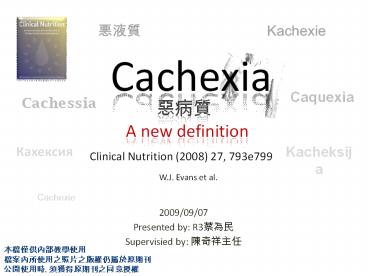Cachexia - PowerPoint PPT Presentation
1 / 32
Title:
Cachexia
Description:
W.J. Evans et al. ??????????. ??????????????????. ?????, ??????????? ... such as melanocortin antagonists and the growth hormone secretagogue, ghrelin ... – PowerPoint PPT presentation
Number of Views:1770
Avg rating:3.0/5.0
Title: Cachexia
1
Cachexia
Kachexie
???
Caquexia
Cachessia
???
A new definition
Kacheksija
????????
Clinical Nutrition (2008) 27, 793e799
W.J. Evans et al.
Cachexie
?????
- 2009/09/07
- Presented by R3???
- Supervisied by ?????
?????????? ?????????????????? ?????, ???????????
2
Definition
3
- Cachexia has long been recognized as
- a syndrome associated with many illnesses
- Underlying mechanisms causing cachexia are not
well understood - No universally agreed upon definition
4
- On December 13th and 14th, 2006, scientists
and clinicians met in Washington, DC, to reach a
consensus on the definition of the constellation
of abnormalities that have been grouped under the
name cachexia
5
Cachexia
Complex metabolic syndrome
Associated with underlying illness
Characteristics
Loss of muscle with or without loss of fat mass
6
Cachexia
The prominent clinical feature..
Children
Adults
weight loss (corrected for fluid retention)
Growth Failure (excluding endocrine disorders)
7
Cachexia
Anorexia
Inflammation
Cachexia
Insulin resistance
Increased muscle protein breakdown
starvation
age-related loss of muscle mass
primary depression
hyperthyroidism
malabsorption
8
(No Transcript)
9
Weight loss
10
Weight loss
Weight loss is a powerful independent variable
that predicts mortality in patients with cancer
11
Weight loss
- Cardiac cachexia is associated with a poor
prognosis, independently of functional severity,
age, and exercise capacity and cardiac function - Weight loss is associated with increased
mortality among elderly people discharged from a
hospital
12
Weight loss
- In elderly nursing home patients a 5 or
greater weight loss in a month is associated with
a 10-fold increase risk of death - In patients with HIV infection, a weight loss
of as little as 3 has been - related to increased
- morbidity and mortality
13
Weight loss
- The risk of death increases with increasing
magnitude of weight loss of decreasing BMI
14
Weight loss
- Therapies that slow disease progression (like
ACE inhibitors in heart failure or effective
antiretroviral therapy in HIV infection) can
prevent weight loss and subsequent adverse
responses
15
Skeletal muscle
16
Skeletal muscle
- Muscle wasting is important in the
pathophysiology of cachexia and a major cause of
fatigue - Several groups of investigators have suggested
that actomyosin(?????), actin(????) and myosin
(????) are selectively targeted for degradation
in clinical conditions associated with cachexia
17
(No Transcript)
18
Skeletal muscle
- The common feature of cachexia, loss of muscle
mass, suggests that therapies targeting muscle or
inflammatory pathways may be effective in
reducing the devastating effects of cachexia.
19
(No Transcript)
20
Skeletal muscle
- For future research, we suggest classifying the
degree of cachexia as mild, moderate or severe,
depending on whether the observed weight loss
within the previous 12 months (or less) is gt5,
gt10 or gt15, respectively.
21
Nutritional factors
22
Nutritional factors
- It is important to distinguish cachexia from
- starvation, malabsorption, hyperthyroidism,
- dehydration or sarcopenia and from
subcutaneous fat loss (lipoatrophy), which can
occur as a side effect of some antiretroviral
therapies in HIV.
23
Nutritional factors
- Anorexia-induced weight loss is due to decreased
energy intake and should be treated with a
nutritional intervention. - Although malnutrition is often present in
cachexia, the clinical characteristic of cachexia
is that it cannot be successfully treated with
nutrition alone
24
Nutritional factors
- One difficulty in identifying cachexia is that it
is often associated with loss of appetite - Anorexia occurs in other conditions that are not
associated with cachexia, such as use of certain
medications, depression, age-associated decrease
in appetite regulation, or gastro-intestinal
problems (e.g. constipation, or delayed gastric
emptying)
25
Treatment options and conclusions
26
Treatment options and conclusions
- The treatment options for cachexia are limited.
Unfortunately, refeeding a patient with cachexia
does not correct the underlying problem - Some potential pharmacological agents include
androgens, selective androgen receptor
modulators, antimyostatin drugs, growth hormone
and insulin-like growth factor, and potential
orexigenic agents such as melanocortin
antagonists and the growth hormone secretagogue,
ghrelin
27
Treatment options and conclusions
- A standard definition of cachexia will help
address a number of outstanding questions - Does the prevention or reversal of weight loss
alone - result in improvement in morbidity and
mortality? - Will targeting skeletal muscle and preventing
its loss - improve outcomes in cachectic patients?
- What is the importance of nutrition and exercise
plus - muscle anabolic therapies in patients being
treated for - cachexia?
28
Treatment options and conclusions
- What is the role of fat loss in cachexia?
- Are cytokines or inflammation central to the
pathophysiology of cachexia? - Does treatment of the underlying illness
completely resolve cachexia?
29
Treatment options and conclusions
- In patients with cancer, does treatment of
cachexia increase the opportunities for cancer
treatment? - By improving outcomes does treatment of cachexia
increase the number of chemotherapy options, for
example? - Is the future of cachexia therapy in combination
therapy?
30
Treatment options and conclusions
- What are appropriate endpoints for regulatory
approval of cachexia therapies? - Can and should the consensus definition of
cachexia be further refined?
31
Treatment options and conclusions
- Our goal is to unify the diagnostic approach to
- cachexia to promote future research
- initiatives in all types of cachexia on all
levels of intervention.
32
(No Transcript)































